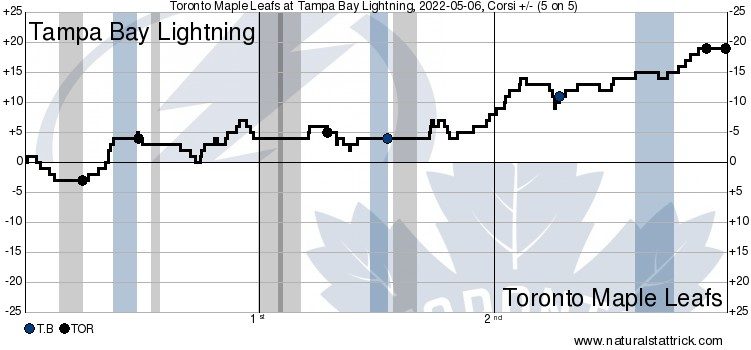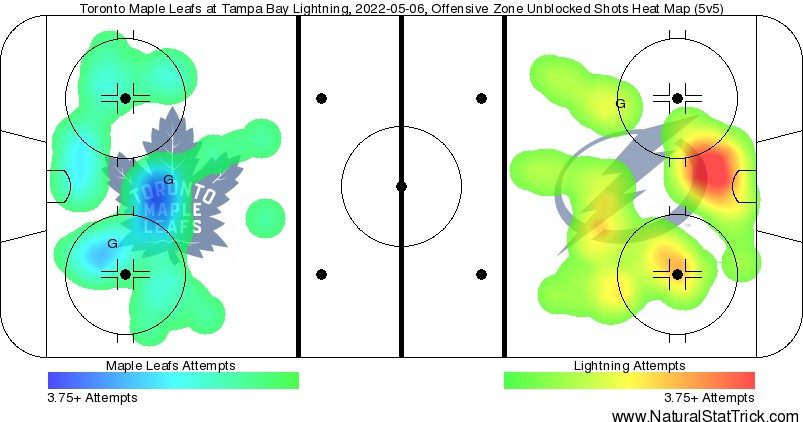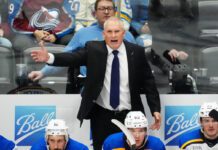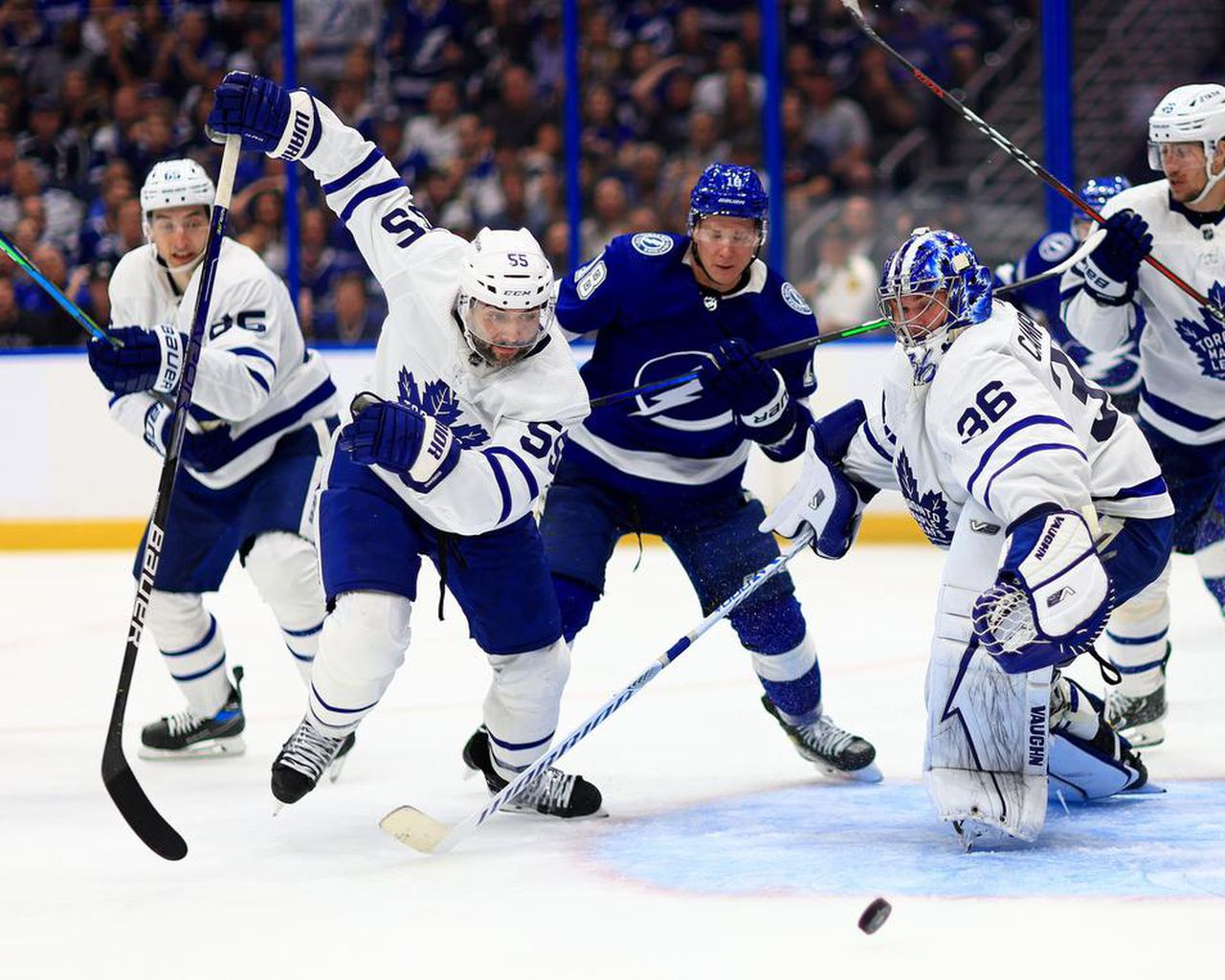Before the game, Jon Cooper noted, “Usually, these odd-numbered games — Games 3 and 5 — in series are pretty pivotal games. This one is not as pivotal as a Game 5, but it’s pretty darn close.”
Without question, this was the best hockey game of this series. The Leafs came out of it on top and now lead the series 2-1.
Let’s break it all down in the game in 10:
1. I’ve always been fascinated by how teams start games — specifically, who the coaches send out for shift one to set the tone. The Leafs have been starting the John Tavares line through the first two games in response to the Lightning declaring a starting lineup featuring Brayden Point – Anthony Cirelli. In this game, Sheldon Keefe switched the opening shift to the Auston Matthews line.
On the first shift, the Lightning got it in deep, and Cirelli laid a big hit on Ilya Lyubushkin, creating a turnover in the slot for Brayden Point, who nearly scored. It was a tough start, particularly for Lyubushkin.
The decision to dress Justin Holl and consequently sit Timothy Liljegren generated a ton of discussion. I am assuming a big part of the coaching staff’s decision-making logic was based on wanting Holl in for the penalty kill. He is a legitimately good penalty killer, and the Lightning power play lit the Leafs up in Game 2.
Jason Spezza was also back in, so he was replacing Liljegren on the power play. If you decide Holl is in fact playing and you’ve completely taken out Liljegren in the process, the question is whether to keep the Rielly – Lyubushkin pairing together or the Giordano – Liljegren pairing together at 5v5.
I am not necessarily saying I agree with it, but that’s really the context of the decision. And Lyubushkin was all over the place in this game, in both a good and bad way.
2. The power play had yet to score on a 5v4 heading into this game, but that changed rather quickly in this one as the Leafs scored on their first PP of the game.
There were some subtle adjustments made on the man advantage by the Leafs. The main one: William Nylander started on the half-wall to begin the power play. The Leafs have been switching Nylander and Mitch Marner on the half-wall — and even moving Auston Matthews to his one-timer side — but Nylander has not generally started on it. He did in this one.
3. The Leafs power play was a little static at the start — specifically, Auston Matthews was taking passes standing still. They are at their best when Matthews catches the puck when skating downhill, and lo and behold, when did the power play break open? After Matthews skated in the middle of the ice from the top of the blue line and shot in stride. They just started firing pucks on net from there.
The goal came off of a Matthews one-timer, a Mitch Marner shot off the rebound, and Morgan Rielly potting Marner’s rebound.
The other thing of note: Sheldon Keefe kept the top unit on for the full two minutes. It’s early in the game, and he’s trying to get them going knowing the importance of the first goal. It worked out in this case.
4. In Game 2, the Lightning had their way with the Leafs on the power play. On the first test in this one, the Leafs’ PK got back to what made them successful in Game 1: preventing Tampa Bay from setting up the zone.
We talked about how the Leafs heavily used TJ Brodie and Justin Holl on the PK throughout the season — particularly during the month of April — but even with Holl back in, it was Muzzin – Brodie opening on the penalty kill.
Right when the Leafs killed it off, Muzzin had the puck on his stick under some pressure in a somewhat similar scenario to how the first period ended in Game 2 (where he couldn’t get it out, and Tampa Bay scored shortly after). This time, Muzzin got the puck out, the Leafs went the other way on a 3-on-1, and they buried it.
A big problem I’ve had with Leafs teams of years past is that it wasn’t always about making the right play; it was about who was the most skilled and getting those players the puck/ice time at all costs. This was a case of simply making the right play.
Pierre Engvall knew it was Ilya Lyubushkin to his right, who is not exactly a playmaker or goal scorer, and you could tell Engvall thought about it for a second. Lyubushkin was simply too open and in too much space, so Engvall dished it and drove the net. Lyubushkin had a special moment and made a special play, setting up Colin Blackwell for the 2-0 goal. That’s good hockey.
5. Alex Killorn ran Justin Holl at the buzzer, a scrum ensued, and the Leafs went to a power play to start the second. It even turned into a 5v3 for 25 seconds (that was a big faceoff loss, essentially negating any opportunity available there).
You have to be careful with this stuff against Tampa Bay; it’s almost like they seek out the antics at times to get themselves fired up and into the game. The Leafs didn’t score on their power plays, and the Lightning seemed to be gaining some momentum, but enter David Kampf.
Kampf is having a series right now. We mentioned Ilya Lyubushkin being everywhere in this one – he picked up an unofficial assist on the goal. With Brandon Hagel coming down the wing, he stepped up and laid a pretty good hit. The puck came out of the zone, Hagel picked up the puck in a similar spot with Lyubushkin again coming for him, and Hagel made a bad pass that resulted in a turnover. Kampf skated down the ice and straight-up beat Andrei Vasilevskiy with a wrister.
That’s two goals now for Kampf in this series, and both have them been him legitimately beating Vasilevskiy clean. There were no rebounds or strange deflections. He has straight up skated down the ice and beat him outright.
Kampf scored one goal in 56 games last season. He’s now up to 11 in 82 this season (one was an empty-net goal). Big-time contributions from role players like this are what make the playoffs so fun.
6. With the score at 3-0, the game seemed to be reasonably under control for the Leafs. Justin Holl played a good first period and contributed to the penalty kill in the first period, as expected. At 3-0, though, he has to back off on the play leading to the 3-1 goal. It simply can’t happen.
It was a bad bounce, and there wasn’t great forward support. You’re up three goals. You’re on the road. You have to skate back and play it safe at that point. He took a penalty on the rush, and the Lightning made them pay this time.
The Leafs also got too carried away on the penalty kill itself. After a turnover in the middle of the ice at the Lightning blue line, instead of getting it back in deep, Alex Kerfoot stopped up with the puck and tried to make a play. He was knocked down, the Lightning went down on an odd-man rush, and the Leafs never recovered the puck before Russ Colton ripped a one-timer.
Those were two really poor instances of situational awareness (or lack thereof) that made it a game again.
7. The Leafs were fortunate to get out of the second period up 3-1. TJ Brodie made a goal-saving dive to deflect the puck on a Colton look at a clean empty net, but even beyond that, Tampa Bay carried play for the final five or so minutes of the period.
I think Keefe and the coaching staff were hyper-aware of it. They came out in the third period and bumped Kerfoot up to the top line. The Ilya Mikheyev – David Kampf – Pierre Engvall line was reunited as well.
It almost paid off with a goal, too. Auston Mathews went on a breakaway (and got his own rebound to no avail). Right after, Mitch Marner fired a shot that glanced off Vasilevskiy and hit the bar.
8. Andrei Vasilevskiy made a few big saves before Tampa Bay went down the ice and made it a one-goal game. It’s not a bad goal on Jack Campbell, but it was saveable.
It was a wrist shot from the top of the circle with minimal traffic in front. If anything, it looked like a bit of a broken play (Campbell had swatted the puck out of mid-air to get it there in the first place), and he was maybe not able to reset himself properly. The puck clipped off his shoulder a bit, but he didn’t get enough of it.
A 3-0 game is now 3-2, and it was fully game on.
9. Even if you didn’t love that goal, Jack Campbell more than stood tall the rest of the way.
Nick Paul walked TJ Brodie and went in all alone; Campbell came up huge with a toe save. On the power play that followed, Steven Stamkos fired a one-timer off of a seam pass, and Campbell shut the door. Brandon Hagel had a good chance in tight shortly after; again, Campbell stood in there.
There has been so much talk about goaltending going into this series — and rightfully so for many reasons — but for me, Campbell outplayed Vasilevskiy in this one, and that was the story. He came up huge with the game on the line.
10. On the penalty kill in the final half of the third and the shifts that followed, the Leafs used a lot of Jake Muzzin – TJ Brodie and Mark Giordano – Justin Holl to close out most of this game. The Pierre Engvall – David Kampf – Ilya Mikheyev line saw a lot of time, and Alex Kerfoot was a staple on the Auston Matthews line with Mitch Marner.
Closing the game with the lead, those were generally the 10 players the Leafs wanted on the ice. For all the criticism he takes — and he did make one bad play — the Lightning scored on the one penalty where Holl was in the box, and he did a good job of helping to kill the other two. Holl helped them close the lead and the game at the end, too.
We are almost at the point where looking at the Leafs lines and debating them is irrelevant. Pierre Engvall was supposed to be on the fourth line – he played 15:09, more than Michael Bunting, Ondrej Kase, and Kerfoot. That great third line we’ve talked about so much was largely reunited in this one. Of any Leafs line in this game, that trio played the third most together.
In terms of matchups in this one, Tampa Bay has committed hard to Brayden Point and Anthony Cirelli line, as well as Victor Hedman and Erik Cernak pairing, matching up against the Matthews line.
The John Tavares – William Nylander reunion created essentially nothing, which has been all too common for them. Neither player has done much for two games in a row, and no other line is making Tampa Bay think twice offensively speaking.
At 5v5, the Leafs aren’t creating a ton outside of the top line (which is why the power play is so important). The third line has been great, but they have been opportunistic offensively more than anything. Tampa Bay controlled play at 5v5 in this one in terms of possession, scoring chances, and expected goals — and it wasn’t just because they were losing, although score effects played a role at the end, of course.
Jack Campbell was excellent, and the Leafs have had a number of players step up with big goals. You need to win games like that in the playoffs, but you have to be honest about what’s happening, too, when planning for the next game.
The de-facto third line has been great, and Matthews and Marner are doing about as well as you can ask against a really difficult matchup. The second line is giving the Leafs very little, and the fourth line without the enforcers at least stopped the antics from Tampa’s Bay fourth line.
The Leafs are up 2-1 in the series. Getting the second line going somehow (do you move Bunting down and keep Kerfoot on the top line? Do you move Nylander up to the top line and have Bunting/Kerfoot/Kase flank Tavares? Is there another option?) would catapult this team to another level.
Game Flow: 5v5 Shot Attempts

Heat Map: 5v5 Shot Attempts































![New Leaf Anthony Stolarz on the opportunity in Toronto: “In Florida, I knew my role as a backup… Now, [Joseph Woll] and I are competing for starts… As a goalie, that’s all you can ask for” Anthony Stolarz, Stanley Cup win, now Maple Leaf](https://mapleleafshotstove.com/wp-content/uploads/2024/07/anthony-stolarz-sc-100x70.jpg)
